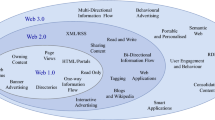Abstract
Traditional distributed transaction processing (TP) systems, such as replicated databases, faced difficulties in getting wide adoption for scenarios of enterprise integration due to the level of mutual trust required. Ironically, public blockchains, which promised to solve the problem of mutual trust in collaborative processes, suffer from issues like scalability, probabilistic transaction finality, and lack of data confidentiality. To tackle these issues, permissioned blockchains were introduced as an alternative approach combining the positives of the two worlds and avoiding their drawbacks. However, no sufficient analysis has been done to emphasize their actual capabilities regarding TP. In this paper, we identify a suitable collection of TP criteria to analyze permissioned blockchains and apply them to a prominent set of these systems. Finally, we compare the derived properties and provide general conclusions.


Similar content being viewed by others
Notes
In fact Bitcoin supports a limited scripting language that allows even more sophisticated programs.
Aura-Authority Round-Wiki. https://wiki.parity.io/Aura. Accessed 14 Aug 2019.
Quorum wiki. https://github.com/jpmorganchase/quorum/wiki. Accessed 14 Aug 2019.
Raft-based consensus for Ethereum/Quorum. https://github.com/jpmorganchase/quorum/blob/master/docs/Consensus/raft.md. Accessed 14 Aug 2019.
Chain Protocol Whitepaper. https://chain.com/docs/1.2/protocol/papers/whitepaper. Accessed 14 Aug 2019.
Hyperledger Sawtooth documentation. https://sawtooth.hyperledger.org/docs/core/releases/latest/. Accessed 14 Aug 2019.
BigchainDB documentation. https://docs.bigchaindb.com/en/latest/. Accessed 14 Aug 2019.
References
Androulaki E et al (2018) Hyperledger Fabric: a distributed operating system for permissioned blockchains. In: Proceedings of the thirteenth EuroSys conference. ACM, pp 30:1–30:15
Angelis SD, Aniello L, Baldoni R, Lombardi F, Margheri A, Sassone V (2018) PBFT vs proof-of-authority: applying the CAP theorem to permissioned blockchain. In: Italian conference on cyber security. University of Southampton, p 11
Bernstein PA, Newcomer E (2009) Principles of transaction processing, 2nd edn. The Morgan Kaufmann series in data management systems. Morgan Kaufmann, San Francisco
Birman K (2007) The promise, and limitations, of gossip protocols. SIGOPS Oper Syst Rev 41(5):8–13
Buchman E, Kwon J, Milosevic Z (2018) The latest gossip on BFT consensus. arXiv preprint arXiv:1807.04938
Cachin C, Vukolic M (2017) Blockchain consensus protocols in the wild (keynote talk). In: DISC 2017, Schloss Dagstuhl–Leibniz-Zentrum fuer Informatik, (LIPIcs), vol 91, pp 1:1–1:16
Castro M, Liskov B (2002) Practical Byzantine fault tolerance and proactive recovery. ACM TOCS 20(4):398–461
Chase B, MacBrough E (2018) Analysis of the XRP Ledger consensus protocol. arXiv preprint arXiv:1802.07242
Correia A et al (2010) Practical database replication. Springer, Berlin, pp 253–285
Croman K et al (2016) On scaling decentralized blockchains. In: Financial cryptography and data security. Springer, Berlin, pp 106–125
Dwork C, Goldberg A, Naor M (2003) On memory-bound functions for fighting spam. In: CRYPTO 2003. Springer, Berlin, pp 426–444
Greenspan G (2015) MultiChain private blockchain. White Paper. https://www.multichain.com/white-paper/
Guerraoui R, Knežević N, Quéma V, Vukolić M (2010) The next 700 BFT protocols. In: Proceedings of the 5th European conference on computer systems, EuroSys’10. ACM, pp 363–376
Haerder T, Reuter A (1983) Principles of transaction-oriented database recovery. ACM CSUR 15(4):287–317
Kemme B, Jiménez-Peris R, Patiño-Martínez M, Alonso G (2010) Database replication: a tutorial, chap 12. Springer, Berlin, pp 219–252
Lin YT (2017) Istanbul Byzantine fault tolerance. https://github.com/ethereum/EIPs/issues/650
Nakamoto S (2008) Bitcoin: a peer-to-peer electronic cash system. White Paper
Qiu D, Srikant R (2004) Modeling and performance analysis of BitTorrent-like peer-to-peer networks. SIGCOMM Comput Commun Rev 34(4):367–378
Sousa J, Bessani A, Vukolic M (2018) A byzantine fault-tolerant ordering service for the Hyperledger Fabric blockchain platform. In: 2018 48th Annual IEEE/IFIP international conference on dependable systems and networks (DSN), pp 51–58
Szilagyi P (2017) Clique PoA protocol & Rinkeby PoA testnet. https://github.com/ethereum/EIPs/issues/225
Tai S, Eberhardt J, Klems M (2017) Not ACID, not BASE, but SALT—a transaction processing perspective on blockchains. In: Proceedings of the 7th international conference on cloud computing and services science. SciTePress, pp 755–764
Wood G (2018) Ethereum: a secure decentralised generalised transaction ledger—Byzantium version. White Paper
Xu X, Pautasso C et al (2016) The blockchain as a software connector. In: 13th Working IEEE/IFIP conference on software architecture, pp 182–191
Acknowledgements
This research was partially funded by the Ministry of Science of Baden-Württemberg, Germany, for the Doctoral Program “Services Computing”.
Author information
Authors and Affiliations
Corresponding author
Rights and permissions
About this article
Cite this article
Falazi, G., Khinchi, V., Breitenbücher, U. et al. Transactional properties of permissioned blockchains. SICS Softw.-Inensiv. Cyber-Phys. Syst. 35, 49–61 (2020). https://doi.org/10.1007/s00450-019-00411-y
Published:
Issue Date:
DOI: https://doi.org/10.1007/s00450-019-00411-y




